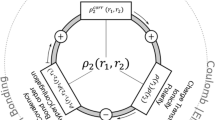Abstract
Three models for constructing topologically related pairs of molecular isomers are discussed at length. The topological-effect-on-molecular-orbitals (TEMO) theorem is presented in detail and illustrated with experimental data; this theorem demonstrates that molecular topology imposes constraints in the form of general interlacing rules on the MO energy patterns of topologically related molecules. Further, non-empirical SCF MO calculations have been performed for topologically related o- and p-divinylbenzenes, difluorobenzenes, benzoquinones, and benzoquinodimethanes in standard and optimized geometries using various basis sets. In most cases, the SCF π-MO eigenvalue patterns of topological related isomers are in complete agreement with the TEMO theorem, thus demonstrating the dominant influence of topology on the π-MO energies. A modified version of the generalized perturbationalvariational Rayleigh-Ritz (PV-RR) procedure is described which is used to study the occasional observed deviations from the TEMO predictions; this procedure had been combined with the concept of critical λ (i.e. the threshold value of the perturbation parameter λ at which the TEMO order of a pair of MO eigenvalues starts to invert), thus enabling us to analyze in quantitative detail the physical factors which compete with molecular topology in conditioning the ab initio MO energy patterns.
Similar content being viewed by others
References
Prelog, V.: J. Mol. Catalysis 1, 159 (1975/76)
Polansky, O. E. in: Application of graph theory in chemistry, Chap. 1, Tyutyulkov, N., Bonchev, D., eds. Sofia: Science and Arts Publisher, in press
Polansky, O. E.: J. Mol. Struct. 113, 281 (1984)
Polansky, O. E., Zander, M.: J. Mol. Struct. 84, 361 (1982)
Polansky, O. E., Zander, M., Motoc, I.: Z. Naturforsch. 38a, 196 (1983); Fabian, W., Motoc, I., Polansky, O. E.: Z. Naturforsch. 38a, 916 (1983)
Motoc, I., Silverman, J. N., Polansky, O. E.: Phys. Rev. A28, 3673 (1983)
Motoc, I., Silverman, J. N., Polansky, O. E.: Chem. Phys. Lett. 103, 285 (1984)
Silverman, J. N., Sobouti, Y.: Astron. Astrophys. 62, 355 (1978);
Silverman, J. N.: J. Phys. A 16, 3471 (1983);
Silverman, J. N., Pakiari, A. H.: in preparation
Graovac, A., Gutman, I., Polansky, O. E.: Mh. Chem. 115, 1 (1984);
Graovac, A., Polansky, O. E.: Croat. Chim. Acta, in press
Ruedenberg, K.: J. Chem. Phys. 22 1878 (1954); 29, 1232 (1958); 34, 1884 (1961)
Weltin, E., Weber, J. P., Heilbronner, E.: Theoret. Chim. Acta (Berl.) 2, 114 (1964), and references cited therein
Graovac, A., Gutman, I., Trinajstic, N.: Topological approach to the chemistry of conjugated molecules, Lecture notes in chemistry, Vol. 4, Berlin: Springer Verlag 1977
Pancir, J.: Coll. Czech. Chem. Comm. 45, 2452, 2463 (1980)
Silverman, J. N.: Phys. Rev. A 23, 441 (1981), and references cited therein
Two independent proofs of (7) are offered: Graovac, A., Gutman, I., Polansky, O. E.: in preparation; Gutman, I., Graovac, A., Polansky, O. E.: in preparation
Potzinger, P., Landers, A.: unpublished results
Schmidt, W.: J. Chem. Phys. 66, 828 (1977)
Galasso, V., Colonna, F. P., Distefano, G.: J. Electron. Spectrosc. Relat. Phenom. 10, 227 (1977)
Motoc, I., Silverman, J. N., Polansky, O. E.: Phys. Rev. A to be submitted
Dupuis, M., Rys, J., King, H. F.: QCPE Program Nos. 401/403, Indiana Univ., Bloomington
Hehre, W. J., Stewart, R. F., Pople, J. A.: J. Chem. Phys. 51, 2657 (1969);
Dunning Jr., T. H., Hay, P. J., in: Modern theoretical chemistry. Vol. 3. Methods of electronic structure theory, p. 1, Schaefer III, H. F. ed. New York: Plenum Press 1977;
Ditchfield, R., Hehre, W. J., Pople, J. A.: J. Chem. Phys. 54, 724 (1971);
Tatewaki, H., Huzinaga, S.: J. Comp. Chem. 1, 205 (1980)
Löwdin, P. O.: J. Chem. Phys. 18, 365 (1950)
Sudhindra, B. S., Olbrich, G., Silverman, J. N.: in preparation
Silverman, J. N.: Phys. Rev. A 28, 498 (1983), and references cited therein
Tables of interatomic distances and configuration in molecules and ions. London: The Chemical Society, 1958
See, for example, Hirschfelder, J. O., Brown, W. B., Epstein, S. T.: Adv. Quantum Chem. 1, 255 (1964)
Author information
Authors and Affiliations
Additional information
Dedicated to Prof. Dr. Günther Wilke on the occasion of his 60th birthday
Part 10 of the TEMO series; for Part 9, see Ref. [9b].
Rights and permissions
About this article
Cite this article
Motoc, I., Silverman, J.N., Polansky, O.E. et al. The effect of molecular topology on π-molecular-orbital energies. Theoret. Chim. Acta 67, 63–89 (1985). https://doi.org/10.1007/BF00547896
Received:
Issue Date:
DOI: https://doi.org/10.1007/BF00547896



